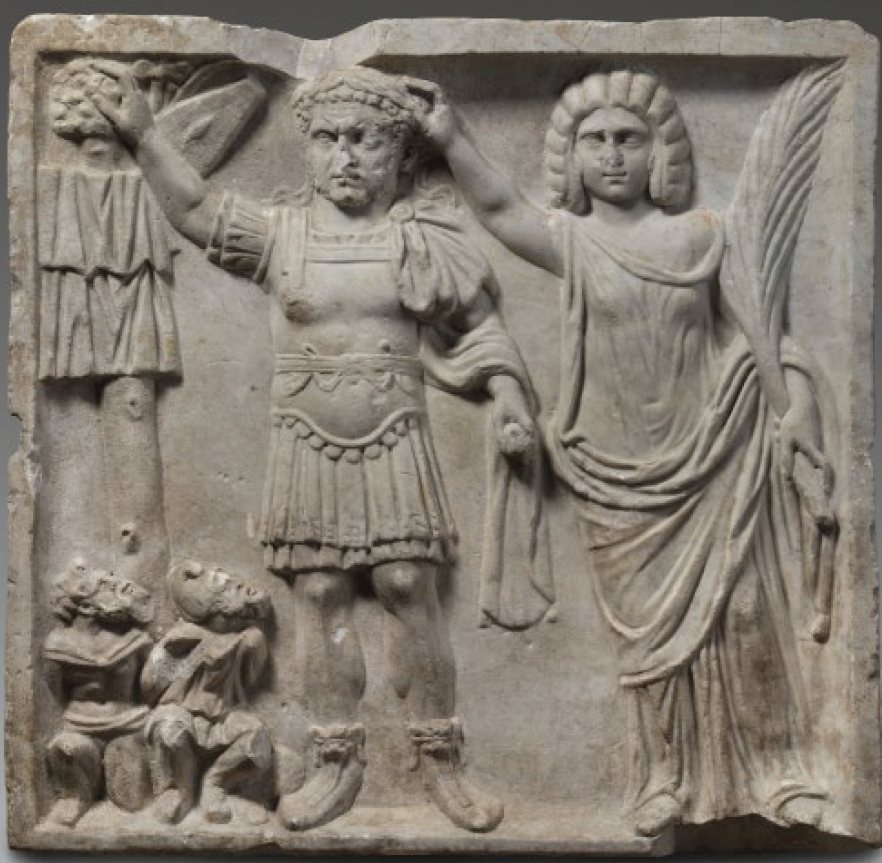Abstrakt
This paper aims to summarize current knowledge on the tropaion. The Warsaw Relief, held in the Gallery of Ancient Art at the National Museum in Warsaw, depicts Emperor Caracalla being crowned with a wreath of victory by his mother, who is shown as Victory. Opposite to the ruler is the title tropaion: a wooden post on which the armour and weapons of defeated enemies were hung (the enemies, in turn, are portrayed at the bottom of the structure). This motif, popular in the Roman world, dates back to at least the fifth century BC. Born in Greece, it was originally linked to the custom of offering the weapons of vanquished foes to the gods. Over the centuries, this practice evolved until, in classical times, it took the form of a post ‘dressed’ in the captured weapons of an opponent, erected immediately after victory. During the era of the great Greek triumphs, a need arose for their lasting commemoration, leading to the creation of permanent stone monuments, also called tropaea. In Republican times, this tradition was adopted by the Romans, who also took over the iconography of the earlier tropaion. A post decorated with captured armaments became one of the most popular propaganda motifs in Roman art.
Bibliografia
Gansiniec Zofia, ‘Geneza Tropajonu’, in Biblioteka Archeologiczna, vol. 5 (Warsaw, 1955).
Janssen Andreas Jozef, Het Antieke Tropaion (Ledeberg, 1957).
Jarych Adam Jakub, ‘On the frontiers of the province: monumentalizing Roman tower trophies in the times of the Roman Republic and Empire’, Novensia, no. 28 (2017), pp. 9–10.
Jarych Adam Jakub, ‘Tropajony na rzymskich monetach w okresie republiki i wczesnego cesarstwa. Kontekst historyczno-typologiczny’, Acta Archaeologica Lodziensia, no. 67 (2021), pp. 57–68.
Lammert Friedrich, ‘Τρόπαιου [Tropaion]’, in Realencyclopädie der classischen Altertumswissenschaft, eds August Friedrich von Pauly, Georg Wissowa, vol. 7A, 13 (Stuttgart, 1939), pp. 663–673.
Picard Gilbert Charles, Les trophées romains: Contribution à l’histoire de la religion et de l’art triomphal de Rome (Paris, 1957).
Pritchett William Kendrick, The Greek State at War, Part I (Berkeley, 1971), The Greek State at War, Part II (Berkeley, 1974), pp. 246–275.
Rabe Britta, Tropaia. τροπή und σκῦλα. Entstehung, Funktion und Bedeutung des griechischen Tropaions (Rahden/Westf., 2008).
Reinach Adolphe Joseph, ‘Tropaeum’, in Dictionnaire des antiquités, eds Charles Victor Daremberg, Edmond Saglio, vol. 9 (Paris, 1912), pp. 497–518.
Reinach Adolphe Joseph, ‘Les trophées et les origines religieuses de la guerre’, Revue internationale d’ethnographie et de sociologie, vol. 4 (1913), pp. 211–237.
Storch R.H., ‘The Trophy and the Cross: Pagan and Christian Symbolism in the Fourth and Fifth Centuries’, in Byzantion, vol. 40 (Brussels, 1971), pp. 105–118.
Tocilescu Grigore Georg, Benndorf Otto, Niemann George, Das Monument von Adamklissi Tropaeum Traiani (Vienna, 1895).
West III William C., ‘The Trophies of the Persian Wars’, Classical Philology, vol. 64, no. 1 (1969), pp. 7–19.
Woelcke Karl, ‘Beiträge zur Geschichte des Tropaions’, Bonner Jahrbücher, vol. 120 (1911), pp. 127–235.

Utwór dostępny jest na licencji Creative Commons Uznanie autorstwa 4.0 Międzynarodowe.
Prawa autorskie (c) 2024 Maciej Marciniak (Autor)


